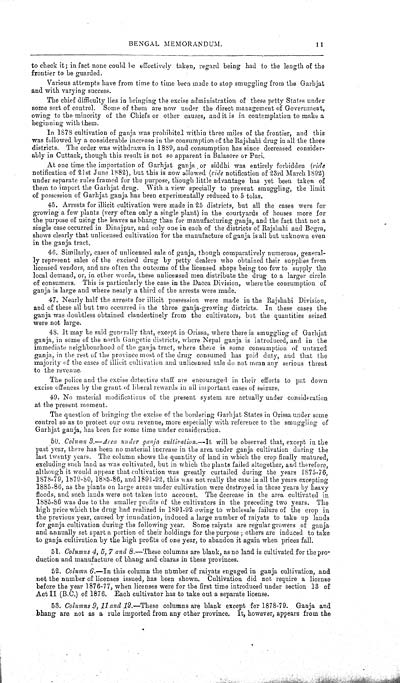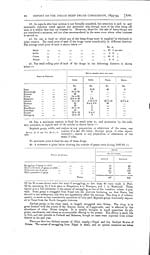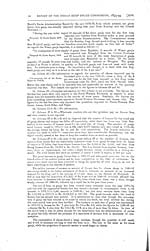Medicine - Drugs > Report of the Indian Hemp Drugs Commission, 1894-1895 > Volume III
(15) Volume 3, Page 11
Thumbnail gallery: Grid view | List view

BENGAL MEMORANDUM. 11
to check it; in fact none
could be effectively taken, regard being had to the length of
the
frontier to be guarded.
Various attempts have
from time to time been made to stop smuggling from the
Garbjat
and with varying success.
The chief difficulty lies
in bringing the excise administration of these petty States
under
some sort of control. Some of them are now under the direct
management of Government,
owing to the minority of the Chiefs or other causes, and it is in
contemplation to make a
beginning with them.
In 1878 cultivation of
ganja was prohibited within three miles of the frontier, and
this
was followed by a considerable increase in the consumption of the
Rajshahi drug in all the three
districts. The order was withdrawn in 1889, and consumption has
since decreased consider-
ably in Cuttack, though this result is not so apparent in Balasore
or Puri.
At one time the
importation of Garhjat ganja or siddhi was entirely forbidden
(vide
notification of 21st June 1882), but this is now
allowed (vide notification of 23rd March 1892)
under separate rules framed for the purpose, though little
advantage has yet been taken of
them to import the Garhjat drug. With a view specially to prevent
smuggling, the limit
of possession of Garhjat ganja has been experimentally reduced to 5
tolas.
45. Arrests
for illicit cultivation were made in 25 districts, but all the
cases were for
growing a few plants (very often only a single plant) in the
courtyards of houses more for
the purpose of using the leaves as bhang than for manufacturing
ganja, and the fact that not a
single case occurred in Dinajpur, and only one in each of the
districts of Rajshahi and Bogra,
shows clearly that unlicensed cultivation for the manufacture of
ganja is all but unknown even
in the ganja tract.
46.
Similarly, cases of unlicensed sale of ganja, though
comparatively numerous, general-
ly represent sales of the excised drug by petty dealers who
obtained their supplies from
licensed vendors, and are often the outcome of the licensed shops
being too few to supply the
local demand, or, in other words, these unlicensed men distribute
the drug to a larger circle
of consumers. This is particularly the case in the Dacca Division,
where the consumption of
ganja is large and where nearly a third of the arrests were
made.
47. Nearly
half the arrests for illicit possession were made in the Rajshahi
Division,
and of these all but two occurred in the three ganja-growing
districts. In these cases the
ganja was doubtless obtained clandestinely from the cultivators,
but the quantities seized
were not large.
48. It may be
said generally that, except in Orissa, where there is smuggling of
Garhjat
ganja, in some of the north Gangetic districts, where Nepal ganja
is introduced, and in the
immediate neighbourhood of the ganja tract, where there is some
consumption of untaxed
ganja, in the rest of the province most of the drug consumed has
paid duty, and that the
majority of the cases of illicit cultivation and unlicensed sale do
not mean any serious threat
to the revenue.
The police and the excise
detective staff are encouraged in their efforts to put down
excise offences by the grant of liberal rewards in all important
cases of seizure.
49. No material
modifications of the present system are actually under
consideration
at the present moment.
The question of bringing
the excise of the bordering Garhjat States in Orissa under
some
control so as to protect our own revenue, more especially with
reference to the smuggling of
Garhjat ganja, has been for some time under
consideration.
50. Column
3.—Area under ganja cultivation.—It will be observed
that, except in the
past year, there has been no material increase in the area under
ganja cultivation during the
last twenty years. The column shows the quantity of land in which
the crop finally matured,
excluding such land as was cultivated, but in which the plants
failed altogether, and therefore,
although it would appear that cultivation was greatly curtailed
during the years 1875-76,
1878-79, 1879-80, 1885-86, and 1891-92, this was not really the
case in all the years excepting
1885-86, as the plants on large areas under cultivation were
destroyed in those years by heavy
floods, and such lands were not taken into account. The decrease in
the area cultivated in
1885-86 was due to the smaller profits of the cultivators in the
preceding two years. The
high price which the drug had realized in 1891-92 owing to
wholesale failure of the crop in
the previous year, caused by inundation, induced a large number of
raiyats to take up lands
for ganja cultivation during the following year. Some raiyats are
regular growers of ganja
and annually set apart a portion of their holdings for the purpose;
others are induced to take
to ganja cultivation by the high profits of one year, to abandon it
again when prices fall.
51.
Columns 4, 5, 7 and 8.—These columns are blank, as no
land is cultivated for the pro-
duction and manufacture of bhang and charas in these
provinces.
52. Column
6.—In this column the number of raiyats engaged in ganja
cultivation, and
not the number of licenses issued, has been shown. Cultivation did
not require a license
before the year 1876-77, when licenses were for the first time
introduced under section 13 of
Act II (B.C.) of 1876. Each cultivator has to take out a separate
license.
53.
Columns 9, 11 and 12.—These columns are blank except
for 1878-79. Ganja and
bhang are not as a rule imported from any other province. It,
however, appears from the
Set display mode to: Large image | Zoom image | Transcription
Images and transcriptions on this page, including medium image downloads, may be used under the Creative Commons Attribution 4.0 International Licence unless otherwise stated. ![]()
| India Papers > Medicine - Drugs > Report of the Indian Hemp Drugs Commission, 1894-1895 > Volume III > (15) Volume 3, Page 11 |
|---|
| Permanent URL | https://digital.nls.uk/74551740 |
|---|---|
| Description | Bengal memorandum, cont. |
| Description | Volume 3: Appendices. Miscellaneous. |
|---|---|
| Attribution and copyright: |
|




